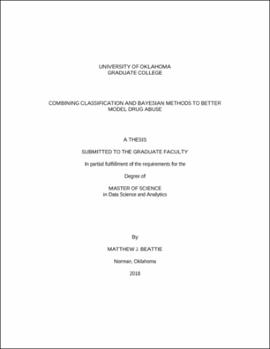| dc.description.abstract | Illicit drug use in the United States has shown no signs of abating, and the morbidity from drug abuse has risen sharply over the last several years. This is primarily due to a rise in the abuse of opioids, including prescription opioids, heroin, and most recently, fentanyl. Finding potential predictors of heroin use could help to reduce fatalities from drug overdose.
There have been many studies to identify correlates of heroin use, and most follow the same methodological pattern. A literature search leads to a pre-selection of a set of predictors, which are then analyzed using traditional statistics – frequentist summaries and logistic regression. This approach limits the potential for finding unexpected combinations of predictors, predictors that correlate with small subject classes, and previously undiscovered predictors. The regression component of the approach is limited by the inability to accept the null hypothesis and it makes no use of information gathered during the literature search.
We propose an improvement to this approach. We believe that principal component analysis and regression tree classification provide methods to objectively identify potential heroin use correlates from the data itself. The information gained by these methods, combined with a review of existing research, allows us to create prior distributions for regressors. We can then use Bayesian Markov Chain-Monte Carlo (MCMC) methods to build predictive models that are more robust than those from traditional approaches.
We demonstrated this approach by modelling the probability of heroin use based upon self-reported factors from a multiyear national dataset. The ease of implementing classification and MCMC modelling allowed us to examine multiple years of data, which in turn enabled us to see how predictors of heroin use have evolved over time. We found that our methods reinforced some beliefs, such as that OxyContin is correlated to heroin use. We also found that they refuted other beliefs, such as that early age of use of drugs is strongly related to potential heroin use. We found that certain usage patterns, such as polyabuse, easy access to heroin, and low perceived risk of heroin use are correlated to heroin use. | en_US |
